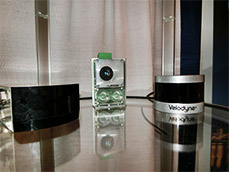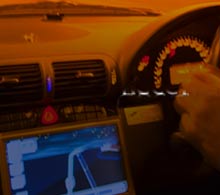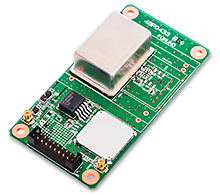Articles for ITS market Germany is first to recognize level 3 automated driving
The US government needs to update and change their policy ?
 The AUVSI Automated Vehicle Symposium was held in San Francisco
The AUVSI Automated Vehicle Symposium was held in San Francisco
 Sponsors of Automated Vehicles Symposium 2017
Sponsors of Automated Vehicles Symposium 2017
 The AUVSI Automated Vehicle Symposium had 1,400 attendees, the largest ever
The AUVSI Automated Vehicle Symposium had 1,400 attendees, the largest ever
I covered the automated driving symposium organized by the Transportation Research Board, an advisory body of the US government. The official name is AUVSI Automated Vehicle Symposium 2017 (July 11 - 13, 2017, San Francisco, California, USA). AUVSI (Association for Unmanned Vehicle System International) is a nonprofit organization.
This symposium has been held annually for the past 6 years, with a record number 1,400 people participating this year. Participants' industries are automobile manufacturers, automobile parts manufacturers, IT industry, electronic equipment manufacturers, government agencies, etc. The attendees encompass countries from all over the world including the United States, Japan, China, South Korea, Taiwan, Singapore, Germany, France and Sweden.
The reason this symposium is attracting attention is because the US is the top leader in the world of autonomous law, maintenance and innovation. However, the future policy concerning automated driving laws from the US government is not clear. U.S. Officials from the administrative agencies with jurisdiction for automated driving did not attend the symposium.
In the same symposium last year, Secretary of State from the Department of Transportation (DOT) and US Highway Transit Authority (NHTSA) attended and made automated driving policy remarks on behalf of the US government. In the latter half of September 2016, two months after the symposium, the US Department of Transportation announced guidelines on automated driving. In this year’s symposium, only a member from the next-generation transport consortium representing government and private companies said "We will enact the automated driving guidelines announced last year."
Many participants said "NHTSA Secretary has currently not been appointed, after the Trump administration was established. Because of this future directions on automated driving in the United States are not currently visible".
Is the US still the leader in the automated driving ?
 Experiment vehicle for Honda's automatic operation.
Experiment vehicle for Honda's automatic operation.
 Various sensors showing the rapid development of automated driving in recent years.
Various sensors showing the rapid development of automated driving in recent years.
Regarding the practical application of automated driving, America has an uncertain atmosphere. Under the current situation will America still be the world leader for automated driving in the future?
The hottest topic in automobile industry now is automated driving. Automobile manufacturers have mass produced technologies such as automatic brakes, automatic door handles, etc. In addition the movement to commercialize unmanned operation called driverless centering by multiple companies is proceeding.
It is America that has led the trend of current automated driving.
When it comes to understanding the history of automated driving, it is said that General Motors (GM) has presented the idea of an "automated highway" at the New York Expo about 80 years ago. This is a concept that expressed the city structure of the future with a large-scale diorama. This futuristic highway would have been automatically driven and controlled by a traffic control center. After the Second World War, running tests of automatic operation by GM and RCA, a major electric manufacturer using real cars were carried out.
However, it is extremely difficult to make the technology for recognizing all surrounding situations small and inexpensive. That is why the hurdle to mass produced automated vehicle operations was very high.
A major change came in the 2000s. Due to the rapid development of the IT industry, semiconductors with high computing power were introduced one after another. Also miniaturization of various sensors using lasers and radars have also advanced. Furthermore, the accuracy and analysis of traveling data and positional information communications has been improved between the vehicle and the cloud.
These various IT technologies have evolved dramatically by government research institutions in the United States and major IT companies around Silicon Valley and Seattle, Washington.
In addition to the rapid evolution of technology in the United States State, governments can independently interpret the Road Traffic Law. Nevada, California and other states have actively approve automated driving on public roads for automobile manufacturers who brought in automated cars for driving tests.
With advanced technology and supporting legislation the United States and manufacturers have pulled together for practical use of automated driving.
I wonder if this trend will be stopped by the US Department of Transportation in the future. However, as you can see from NHTSA’s absence from the meetings, it is clear that the future of the traffic administration in the United States is uncertain, and this influence extends to automated driving.
Germany has become the first country to recognize level 3 automated driving.
The week after the symposium was held, a bill representing automated driving was passed in the US House of Representatives. This new policy from the federal government outlines public road testing and automated driving for mass production devices. In the future, the bill will be deliberated in the Senate.
While the United States continues to work on legal issues, in June Germany created an amendment for the Road Traffic Law which includes clauses on automated driving and it is one step ahead of the United States.
In response to this, Audi, a luxury brand of the VW Group, unveiled a new A8, a large sedan equipped with the automatic level 3 driving function of in early July. Level 3 refers to the vehicle control function during automatic operation without driver intervention.
It was the first time Germany has allowed Level 3 control.
The background is the "twist phenomenon" of two treaties, the Geneva Convention and the Vienna Convention, which are global agreements on the Road Traffic Act.
In the Vienna Convention, where Japan and the United States are not affiliated, amendments to the treaties took into account automatic operation have been in effect since March 2016. On the other hand, the prospects for revision to the Geneva Convention are not in place at the moment.
In Germany, in order to take the initiative on automated driving ahead of Japan and the United States, the German domestic law was revised using the Vienna treaty as a reference allowing them to realizing the image as an advanced country for automated driving.
The United States had been driving the law regulations and technical aspects of automated driving so far. It is unknown if this will continue in the future as they try to catch up to Germany.
Writer introduction

Mr. Kenji Momota Automotive journalist
His major is the world automotive industry and he is also familiar with the energy industry, IT and the aging society problem as the related fields. He acts around the world based in Japan and USA and writes for the general magazines, the technology journals and the automotive related media etc.
He is also commentator of motor race and world's motor show on TV program based on his career of the driver of Indy Racing League and NASCAR. In recent years, he has been covering about a paradigm shift from developed countries to developing countries, the motorized vehicle like EV and the telematics.
FURUNO ITS Journal
Click here for the latest articles after 2022 (in Japanese)2022
- The "realistic" self-driving roadmap shown by the Japanese government and a hands-on report on the latest Subaru EyeSight X
- Will FCVs (Fuel Cell Vehicles) Become Popular? ~New Movement in Toyota and Honda~
- The 'Complete' online sales of new cars start in Japan. Will this new way of buying cars take root?
- Many Firsts! On-Site Report from Tokyo Auto Salon 2022 - The author, who knows what goes on behind the scenes, looks back on 40 years of history. -
2021
- "Moving toward zero traffic fatalities for four-wheeled and two-wheeled vehicles globally in 2050" ~Experience on Honda's latest safety technologies~
- Tsuneishi Shipbuilding's building and DX, an exclusive visit to the main factory
- Japan's Smart City: New Moves toward Practical Use
- When will self-driving buses (service cars) be put to "full-scale" practical use?
- Utilization vehicle data during disasters
- Toyota-led Connected Technology to Transform Commercial Vehicle Business -From light trucks to large trucks and buses-
- Toyota enters the connected car "Personalization" business
- Japanese automakers' carbon-neutral strategies swept up in ESG investment
- Drive experience of the latest autonomous vehicle models and advanced driving support systems
- Will carbon neutrality accelerate the trend to strengthen LCA (Life Cycle Assessment)?
- Semiconductor shortage exposes realities of the automotive industry
- Online Autonomous Driving Contest Enhancing development of Human Resources
2020
- What happens to CASE when gas cars are banned in Japan?
- When will Flying Cars be launched?
- Expectation vs. reality:Autonomous Driving in Japan
- V2X, Becoming increasingly important in autonomous driving
- Technology of Subaru “EyeSight X”
- Lifestyle-oriented French cars gain popularity in Japan
- Human-oriented smart cities are wanted
- MaaS and CASE, how would automotive industry change after COVID-19?
- The beginning of virtualization era, triggered by COVID-19
- Trend of EV shift and consumer demands
- TOYOTA Press conference about ADAS - Releasing algorithm for "sudden acceleration suppression during attempted sudden acceleration" free of charge -
- The Japanese automotive industry in 2020 - 3 turning points -
- "Using a smartphone while driving" and "Level 3 automated driving"
2019
- Motor show business model is at a turning point - Tokyo Motor Show Report -
- Commercialization and monetization of MaaS - ITS World Congress Singapore Report -
- Android Automotive pays attention to V2X - Report from the Frankfurt Motor Show 2019 in Germany -
- Automobile Distribution Revolution and DCM (Data Communication Module)
- Connected business potential and newly proposed "eMaaS" by Honda
- 5G services for practical use are multiplying
- Connectivity technologies attracting attention due to frequent traffic accidents
- Shanghai Motor Show report -SUV, EV, Automated car & 5G-
- Drone Business roadmap and updates to Michibiki (Quasi-Zenith Satellite System)
- MaaS (Mobility as a Service) "town development." Full-scale promotion for a national project
- CES organizer states "Data Period in 2020s." Transformation of the Automotive Industry in CES, US "-CES2019 Report-"
- "Return to Origin" directed towards the age of change, automatic operation and connectivity
2018
- New proposal for Private Car Automated Driving Level and other Hot 5G Technology Topics
- Standardized EV charging infrastructure concerns in Europe, US, Japan and China - Kobe EVS 31 field report -
- Touring a pure car carrier and a test drive of the latest hybrid car
- Planning stage products are exhibited at the newly established visualized mobility service "TOYOTA MOBILITY SHOWROOM".
- Potential “Community Car-share” program promoted by local residents
- CES Asia Report 2108
- Companies attempt new Vehicle-to-Infrastructure communications, including traffic volume measurements and vehicle positioning. -ITS Asia Pacific Forum in Fukuoka-
- Geneva show in Switzerland. Flying cars and MaaS (Mobility as a Service) were hot topics.
- EV (Electric Vehicle) proposals by country
- MaaS competition through service mobilization, M & A and technical field collaboration is accelerating. - The CES 2018 Report -
2017
- Big data’s initiative and fight for the automotive industry. Cooperation among companies becomes increasingly important.
- Connected car and road-to-vehicle communication automatic operation
- ETC (Electronic Toll Collection) and ETC2.0. Current situation and projected future
- Rapid development of sharing economy
- Germany is first to recognize level 3 automated driving
- ITS EU 2017 Field Reports -Automatic Operation and the eCall-
- From Infotainment to ITS, the competitive area is spreading in the car big data industry.
- GTC (GPU Technology Conference) Report and the de facto standardization of AI (artificial intelligence)
- Renesas' new challenge! "e-AI Solution" and "Renesas Autonomy"
- The Automobile industry is shifting from a manufacturing industry to a service industry.
- The movement toward accident countermeasures for aging drivers in Japan
- Fusion of ride sharing and fully automated driving is advancing in the USA.
2016
- Overview of the Quasi-Zenith Satellite System (QZSS) and advancements toward full-scale practical use including the Tokyo Olympic Games - G-space EXPO 2016 report-
- Japan’s automated driving project "SIP-adus" will be a large demonstration experiment.
- The International Home Care & Rehabilitation Exhibition. There were many car manufactures with exhibits booths at this show.
- Japanese car manufacturers starting to concentrate on strengthening the ADAS system
- A new movement of legislation for autonomous cars
- Cyber Security and “AGL”, the new OS for automotive are hot topics in the connected car industry
- “High precision 3D map” the key future of autonomous car and pedestrian dead reckoning
- Chinese “BAT” is accelerating their business in the EV (Electric Vehicle) market
- Tesla's original connection to Taiwan and the new transportation system technologies.
- "The main topic" of the Geneva Motor Show was how to strengthen "pedestrian protection"
- The probe data business is getting more competitive
- Reporting directly from the 2016 CES show "Data services will soon become the main revenue source of automotive industry"
2015
- Do the automated driving systems need the GNSS (Global Navigation Satellite System) ?
- ETC Version 2.0 is coming soon. A new service was announced at the Tokyo Motor Show and the possibility that is could be used as a device for older drivers.
- "Connected Horizon" and "eHorizon". Germany's leading parts supplier accelerates strengthening of "Big Data" for business



 Symposium sponsorship speech
Symposium sponsorship speech GPS/GNSS Receiver&Chips and Modules (positioning and timing)
GPS/GNSS Receiver&Chips and Modules (positioning and timing)